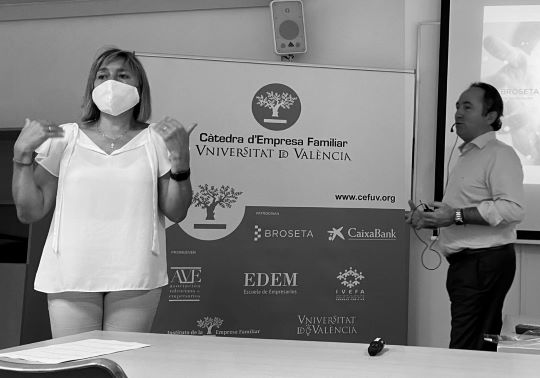
Last Monday, June 28, the sixth session of the Family Business Course: Key aspects for its competitiveness and durability (13th Edition) was given by Pilar González, professor of psychology at the Universitat de València.
Pilar González led a session focused on conflict management in the Family Business, and began by asking attendees how do they realize that there is a conflict in a Family Business?, attacking ideas, arguments to defend positions are presented with a lot of violence, there is no progress towards a solution, coalitions are formed , they are not listened to, members misrepresent the contributions of others... these are some of the conclusions that were discussed at the session.
Subsequently, we had a group exercise to understand the 4 potential sources of the conflict:
- Existence of scarce resources
- Procedural disagreements
- Interdependence of work activities
- Differences in values or perceptions
The attendees prepared fictitious experiences of cases where the four sources of the conflict appear, and then each group exposes it.
Through the Thomas matrix, we observe that conflict management intentions are classified into two levels, the first is the level of selfishness (attempt to satisfy one's own interests), and the second is the level of cooperation (attempt to satisfy the interests of the other), the matrix is composed:
High level of selfishness and high level of cooperation: Collaborator
Low level of selfishness and high level of cooperation: Servility
High level of selfishness and low level of cooperation: Competitive
Low level of selfishness and low level of cooperation: Avoidance
The matrix serves to identify what position each subject is in, once identified it can manage the conflict in one way or another.
Then, the professor addressed the issue of mediation in the face of conflict, explained the protocol of mediation that consists of: preparation, meeting, collection of information, confirmation of information, generation of alternatives, evaluation of options, discuss and select options, closure and agreement.
Finally, Pilar explained two quite important concepts in the management of a conflict, on the one hand, active listening that consists of the physical and mental effort to capture the entire message and interpret it correctly, some tips to achieve active listening: be aware of the other, observe and interrogate yourself constantly, feedback and detect keywords , and on the other hand, feedback consisting of a short repetition of what the other has said, with their own words and trying to be objective.
The second part of the day was in charge of Alejandro Ríos, Partner – Lawyer of Broseta Abogados, who led a session focused on the commercial organization and family protocols in the Family Business.
Alejandro began the session by explaining the three integral elements in the Family Business:
- owner
- managerial
- familiar
The relationships between these three elements may change over time, but their presence is consubstantial to the FF's own life.
The session continued by highlighting a series of factors that cause specific problems for FF: Doubts about its continuity, lack of transparency that ends in distrust, personalist management with little professionalization, confusion between ownership and management and the presence of conflicts of interest. However, it has differentiating positive aspects such as its long-term vision and greater flexibility in equity if managed properly.
Subsequently, the professor addressed the issue of the family protocol, which is an "ad hoc" document, which establishes the family's agreements regarding its relationship with the company and the property, in order to ensure the continuity of the FF. In addition, the protocol helps the family to have a embodition of their company culture, is a means to avoid problems and a guide to channel solutions, maintains cohesion and family harmony, marks the objectives to be followed in the company, reconciles family and business interests, establishes a succession mechanism, regulates wealth and facilitates business management.
Finally, Alejandro recalled the organs of the family (Family Assembly and Family Council) and the company (General Meeting of Partners and Board of Directors).
In addition, he explained the tools of the Family Council to avoid the imbalance between the company and family:
SCOPE OF THE ORGANIZATION
- Forum for information about the company and independent debate.
- Hinge between the company and the family.
- Single voice on both sides.
- Improvement of knowledge about the business enterprise.
- Encourage training.
- Family Office.
- Succession processes.
SCOPE OF THE FAMILY
- Interpreting body of the Protocol.
- Foster cohesion between the family.
- Define and transmit values.
- Build trust and, where appropriate, resolve conflicts.
- Follow-up of family members in the company.
- Involve future generations.








